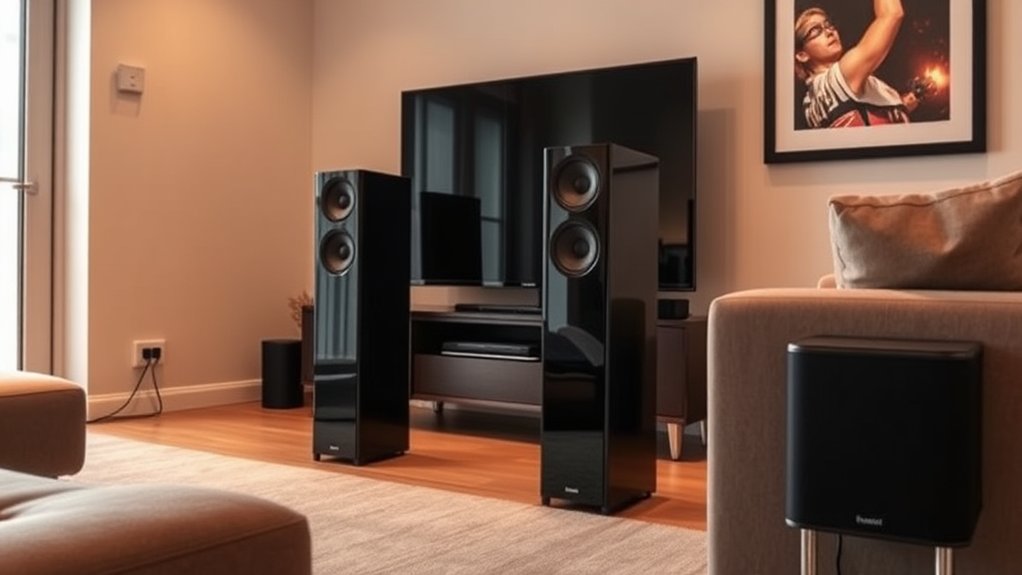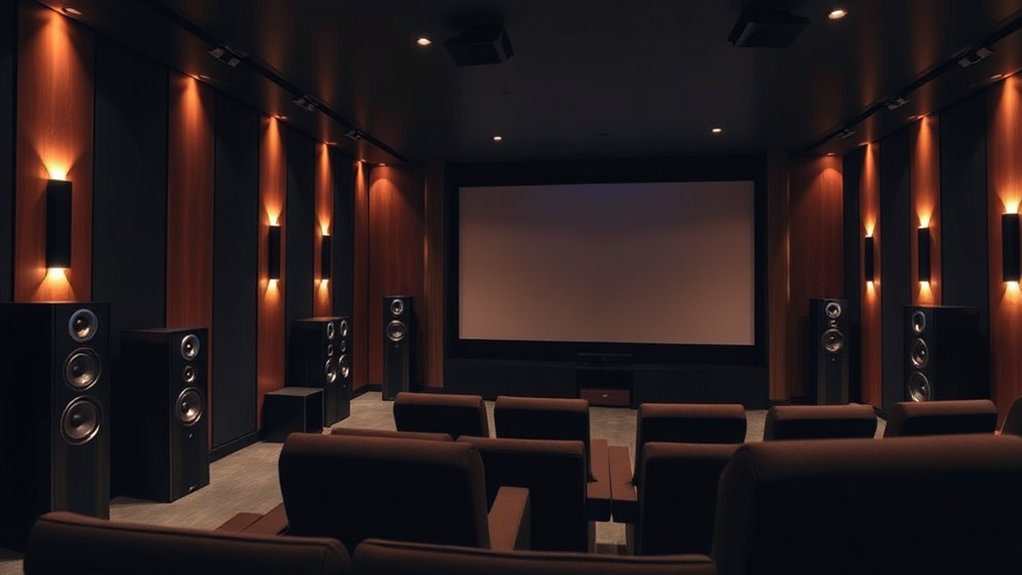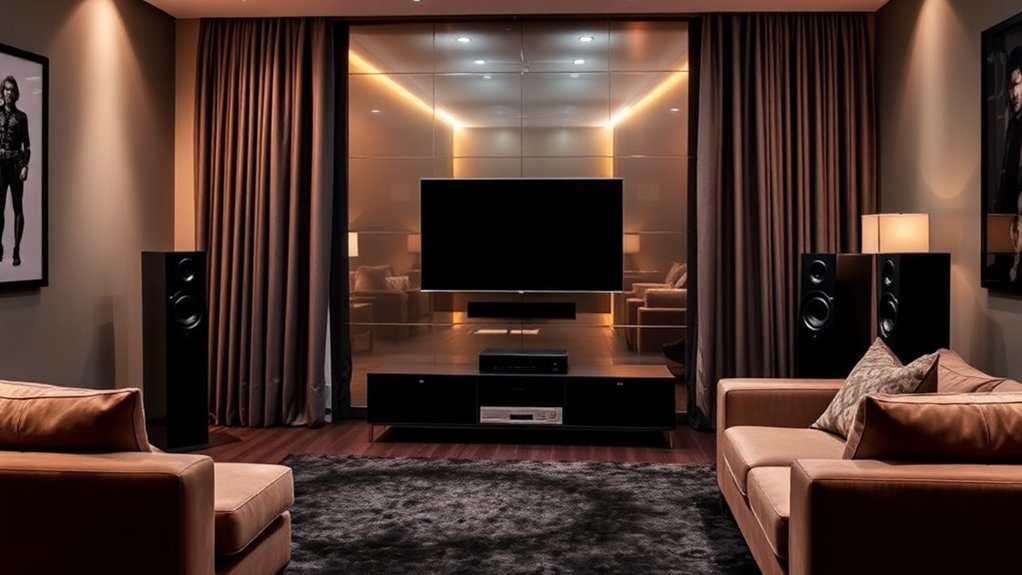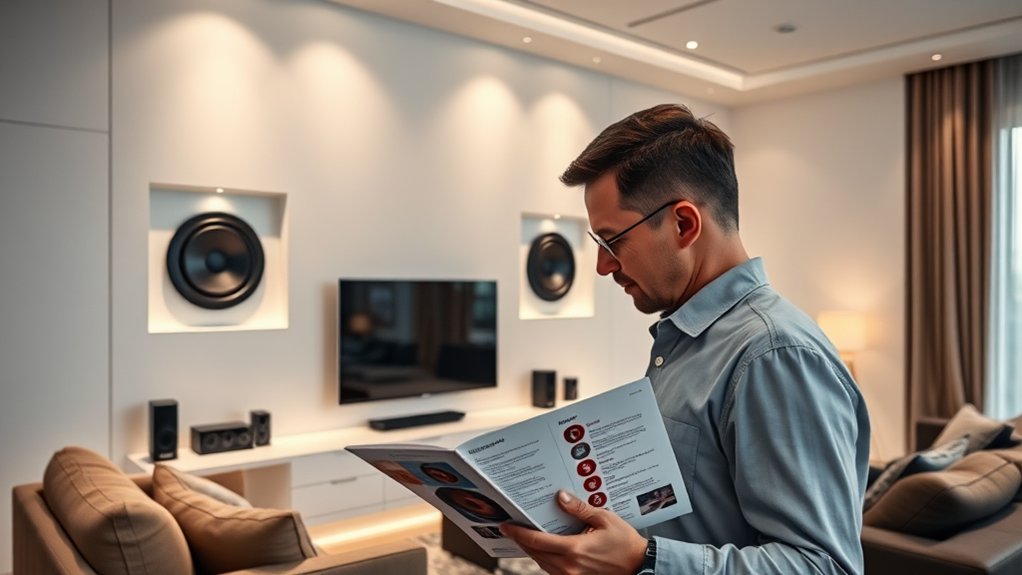To set up your home theater speakers with a wireless subwoofer, start by choosing a rectangular room, ideally with soft furnishings to improve acoustics. Position the subwoofer about a third into the room, avoiding walls to reduce boomy sound. Make sure your receiver’s auto-calibration features are activated for the best sound alignment, and set speaker sizes to “small” for the best bass integration. Adjust the levels for a harmonious blend, and you’ll soon grasp the nuances of your audio experience. Curious about fine-tuning?
Key Highlights
- Position the wireless subwoofer one-third into the room to achieve balanced bass response, avoiding corners and walls for optimal sound quality.
- Use a setup microphone for auto-calibration, ensuring accurate distance measurements from the listening position to each speaker.
- Align the subwoofer with main speakers to minimize timing delays and improve overall audio coherence.
- Place front speakers at 22 to 30 degrees off-axis, ensuring the center channel is aligned with the seating area for better dialogue clarity.
- Regularly dust and inspect cables for wear, and adjust settings based on room acoustics to maintain optimal performance and sound quality.
Choosing the Right Room for Your Home Theater Setup
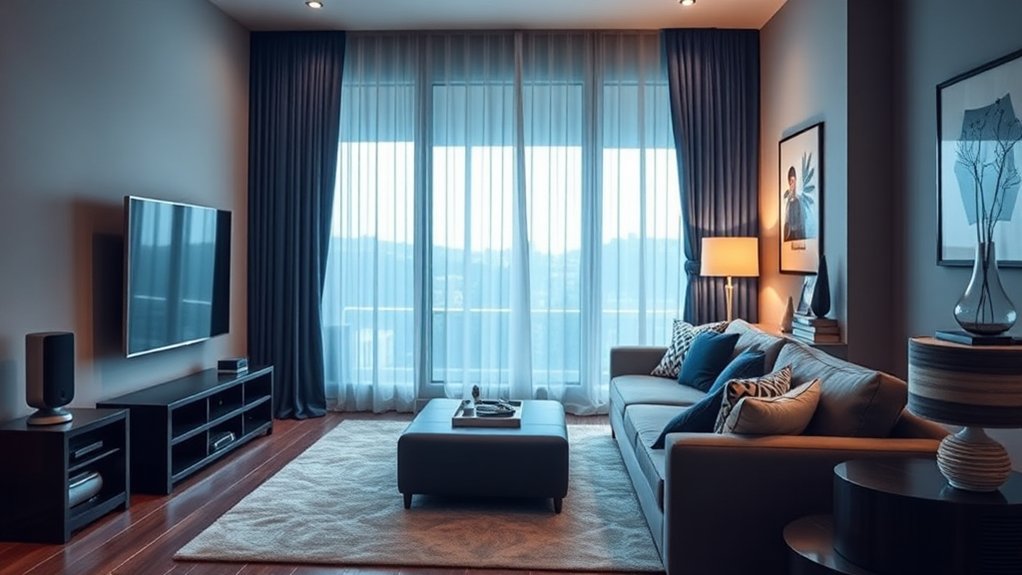
When you’re considering setting up a home theater, have you given much thought to which room will be the best fit?
Ideally, you want a space that’s about 24 feet long and 15 feet wide with at least a 9-foot ceiling. Why, you ask? Well, it helps avoid those troublesome acoustic issues that ruin movie nights, like echo and muddiness. The golden ratio affects sound experience, so keeping these dimensions in mind can enhance your audio quality. Speaker placement can greatly impact how sound is perceived in your home theater setup, so ensure that your speakers are arranged thoughtfully within the space. Incorporating surround sound options such as detachable speakers can further elevate the audio experience, ensuring you achieve an immersive setup.
Rectangular rooms are your friends; they provide better sound control and room for seating arrangements. Just steer clear of cube-shaped rooms that can turn your epic films into distorted audio nightmares.
Choose a room away from noisy areas, with solid walls and soft furnishings to minimize distractions, ensuring your home theater experience is nothing short of immersive—and worth every penny.
Optimal Subwoofer Placement Techniques
Now that you’ve pinpointed the perfect room for your home theater setup, it’s time to tackle one of the most pivotal aspects of audio performance: subwoofer placement.
Start by placing your subwoofer at ear height in your main listening position, then crawl around the room’s perimeter to find where the bass sounds fullest. Keep it away from corners and walls to avoid that boomy sound. Ideally, position it about one-third into the room for balanced bass response, as room interaction can greatly affect low frequencies. Align it with your main speakers to minimize timing delays. Subwoofer placement should also consider that multiple subwoofers can enhance performance. Many soundbars, especially the top recommendations in 2023, incorporate advanced audio enhancement technologies to improve low-frequency output despite the absence of a dedicated subwoofer.
Don’t be afraid to experiment—sometimes placing the sub behind your listening spot can even yield surprising results. Remember, a little patience and keen listening can pay off immensely!
Setting Up Wireless Connectivity for Your Subwoofer
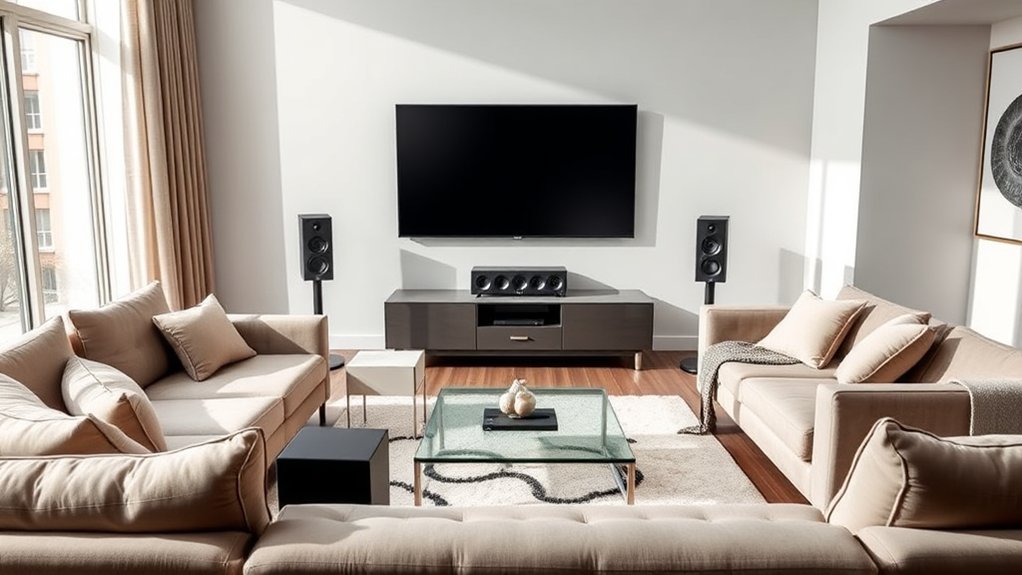
Establishing wireless connectivity for your subwoofer opens up a world of convenience and flexibility, allowing you to position your audio equipment without the hassle of running cables across the room.
First, pick a wireless subwoofer that’s compatible with your existing receiver or soundbar; it’s like finding the perfect performance partner! Make sure it supports Wi-Fi or Bluetooth connectivity, and if possible, opt for models featuring auto-calibration to simplify setup. Proper subwoofer setup significantly impacts overall sound quality, enhancing your listening experience.
Before powering it up, place the subwoofer on the same wall as your audio gear to maximize signal integrity. Pair it using the provided transmitter or a built-in wireless pairing feature.
Finally, check that nothing obstructs the signal (like big furniture) and celebrate your newfound wireless freedom with some killer bass!
Receiver Configuration for Accurate Sound
Getting your receiver configured correctly is crucial for achieving that cinematic sound experience you crave, especially since a well-calibrated setup can make the difference between hearing a faint whisper and feeling the intensity of an explosion in the latest blockbuster.
Start by using the setup microphone for auto-calibration—this tool helps measure your room’s acoustics and speaker positions. Don’t forget to input accurate distances from your primary listening spot to each speaker, including the subwoofer, ensuring perfect synchronization.
Adjust your speaker sizes to “small” if necessary, so low frequencies route through the subwoofer. Remember to tweak the crossover settings and volume levels until everything blends harmoniously—after all, no one wants a bassline that takes over the dialogue!
Speaker Arrangement for Home Theater Systems
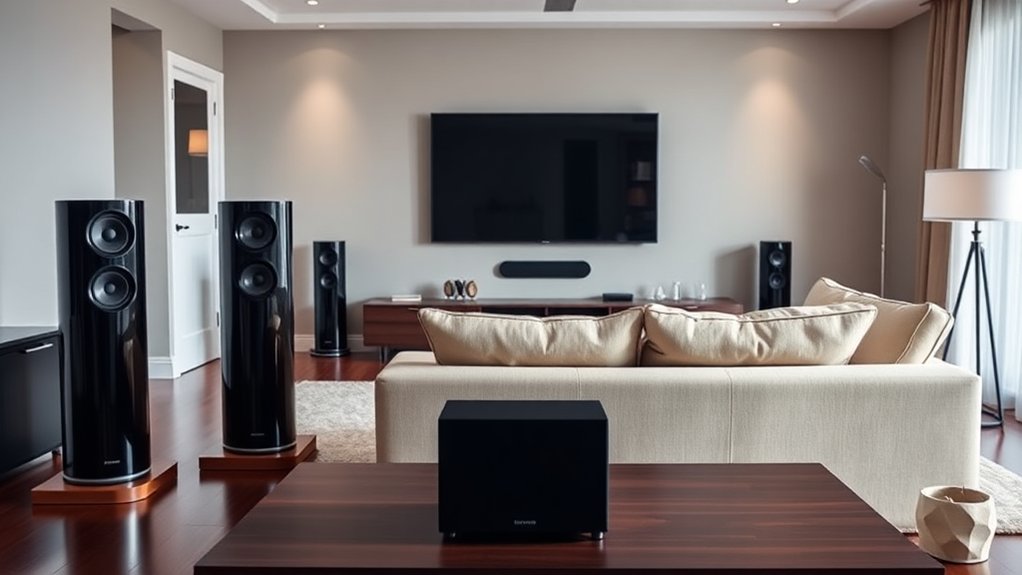
When setting up your home theater speakers, a well-thought-out arrangement can make all the difference between a good audio experience and an extraordinary one.
Start by positioning your front left and right speakers about 22 to 30 degrees off-axis, toed-in toward your main listening area for ideal sound. Ensure tweeters are at ear level, which is essential for clear highs.
The center channel speaker should align directly with your seating to anchor dialogue, ideally placed close to the screen.
For surround sound, position side speakers at 90 to 110 degrees off-axis, slightly above ear level. Remember, no physical barriers should obstruct their output.
Have you ever heard muffled dialogue? That’s a sign something’s off in your speaker arrangement!
Managing Room Acoustics for Enhanced Audio
You’ve got your speakers arranged just right, but there’s more to elevating your home theater experience than just placement—they also need a solid acoustic environment to thrive.
To achieve this, consider integrating room equalization technology, which employs a microphone to assess audio response. By measuring frequency peaks and dips, it smooths the overall sound.
In addition, multiple subwoofers scattered around the room can help minimize bass issues by dispersing energy from different points—after all, who wants to experience uneven bass?
Don’t forget bass traps either; they’re crucial for absorbing low frequencies that can create chaotic sound pressure.
Finally, strategic acoustic panel placement can refine mid and high frequencies. It’s like giving your audio a little makeover, right? Advanced features like Dolby Atmos can further enhance your sound experience by creating realistic soundscapes.
Fine-Tuning Subwoofer and Speaker Levels
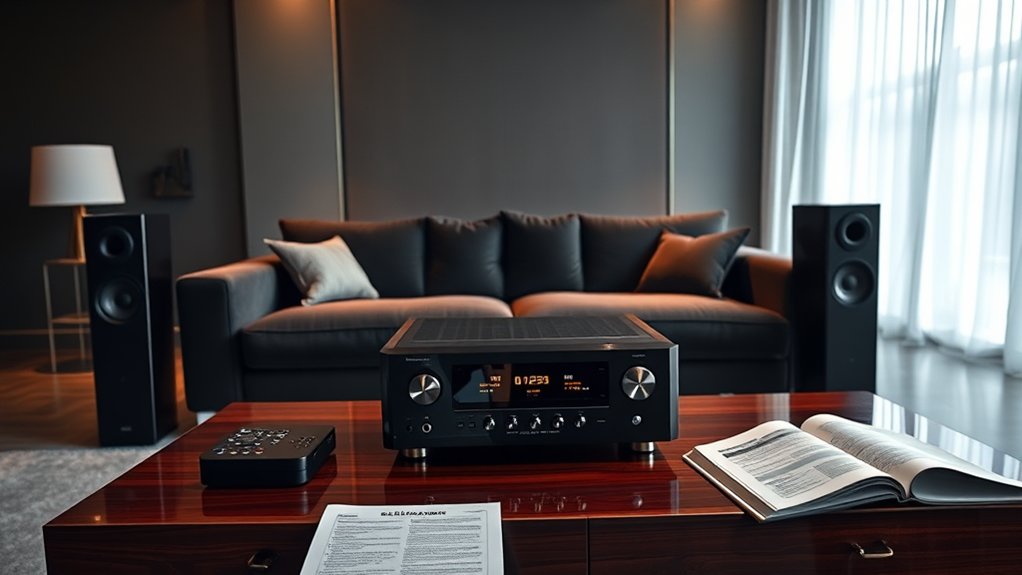
Fine-tuning subwoofer and speaker levels is vital for achieving that movie-theater-quality sound right in your living room.
Start by setting your subwoofer volume to the midpoint—think 12 or 1 o’clock for rotary knobs, or around -15 for digital controls. With the phase control at 0 degrees and the Low Pass Filter disabled, you’re primed for success!
Next, position your main speakers, labeling them as “small” in your AV receiver. Don’t forget to use an SPL meter or smartphone app at your listening position to gauge sound levels—this isn’t just guesswork.
Position your main speakers as “small” in your AV receiver and use an SPL meter for accurate sound level measurement.
Adjust levels to create a cohesive sound, watching for overpowering bass. Remember, subtle changes lead to smoother integration—because who really enjoys a bass party all on its own? Additionally, implementing features like adaptive sound technology can enhance the clarity and detail of your audio experience.
Addressing Wireless Interference Issues
How can you enjoy that cinematic experience at home without bothersome interruptions from wireless interference?
Start by positioning your wireless subwoofer closer to your receiver or soundbar, reducing the distance that signals must travel and enhancing connection stability.
Remove obstacles like walls or furniture that can block signals, as they’re like roadblocks on the highway of audio. Additionally, keep your subwoofer away from microwave ovens and routers, which can be noisy neighbors in the electromagnetic spectrum.
To further minimize interference, consider switching other devices to wired connections or utilizing wireless systems that operate on less congested frequency bands. For example, many modern soundbars, such as those equipped with Dolby Atmos technology, can provide an immersive audio experience that might require careful setup to ensure optimal performance.
Finally, periodically reset RF channels in your setup—think of it as giving your system a little refresh to maintain peak performance.
Regular Maintenance and Upgrades for Performance
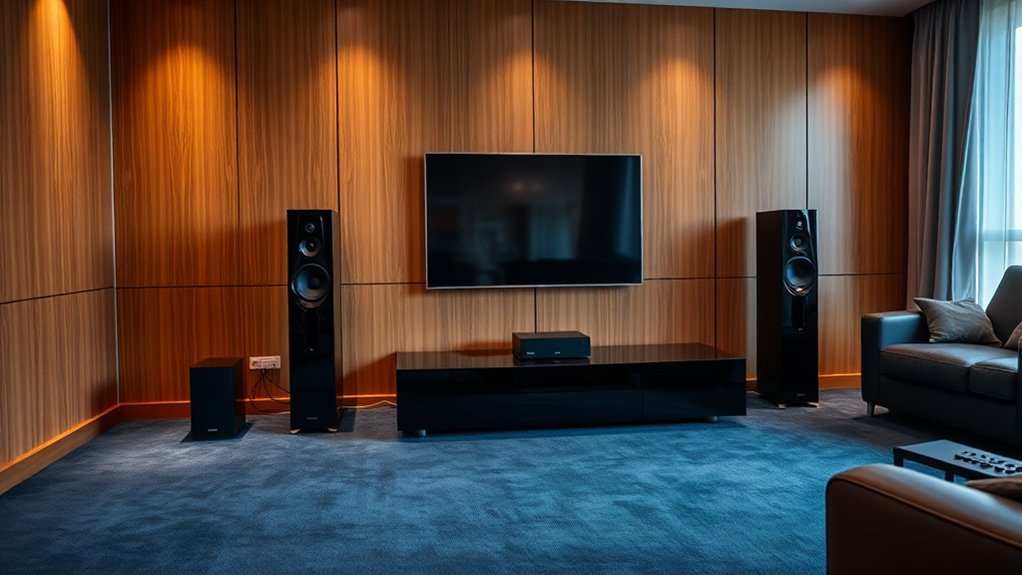
Even though you might be tempted to just set up your home theater and press play, regular maintenance and upgrades are essential to keep your sound system performing at its best.
Start by gently dusting your speakers with a microfiber cloth; after all, who wants to listen to music through a layer of grime?
Dust off those speakers with a microfiber cloth—clean sound deserves a clean surface!
Next, inspect cables and connections for wear—think of them as your system’s veins, imperative for good health.
Keep an eye on the room’s temperature and humidity, too; extreme changes can wear out your components faster than you can say “surround sound.”
Finally, consider upgrading to higher-quality cables or additional subwoofers for even better performance. Integrating a Trueplay technology adjustment based on room acoustics can further enhance your listening experience.
It’s these little things that can make a huge difference in your listening experience!
Frequently Asked Questions
How Do I Choose the Right Subwoofer for My System?
To choose the right subwoofer for your system, consider the room size, power handling, driver size, and your listening preferences. Match specifications for ideal integration, ensuring efficient bass performance tailored to your audio needs.
Can I Use a Wired Subwoofer With a Wireless Setup?
You can use a wired subwoofer with a wireless setup, but you’ll need a wireless audio transmitter and receiver. This lets you enjoy the benefits of wired sound quality during maintaining some wireless convenience.
How Do I Determine the Right Crossover Frequency?
To determine the right crossover frequency, check your speakers’ specs, set it about 10 Hz above their lower limit, and test different frequencies by ear for best integration and sound quality in your setup.
What Should I Do if the Subwoofer Isn’T Turning On?
If your subwoofer isn’t turning on, check the power supply and connections first. Confirm it’s plugged in and the power switch is on. Reset it by unplugging for a minute, then reconnecting.
Can Speakers of Different Brands Work Well Together in My Setup?
Yes, speakers of different brands can work together in your setup, but mismatched tonal qualities might affect sound quality. Verify they’re compatible and consider using a receiver that allows for manual adjustments to optimize performance.

